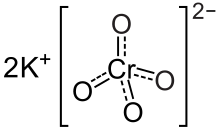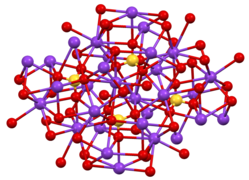Potassium chromate
 | |
 | |
| Names | |
|---|---|
| IUPAC name Potassium chromate | |
| Other names Potassium dichromate, Chromic acid, (K2CrO4), dipotassium salt | |
| Identifiers | |
CAS Number |
|
3D model (JSmol) |
|
| ChEBI |
|
| ChemSpider |
|
| ECHA InfoCard | 100.029.218 |
| EC Number |
|
PubChem CID |
|
| RTECS number |
|
| UNII |
|
| UN number | 3077 |
CompTox Dashboard (EPA) |
|
InChI
| |
| |
| Properties | |
Chemical formula | K 2CrO 4 |
| Molar mass | 194.189 g·mol−1 |
| Appearance | Yellow powder |
| Odor | odorless |
| Density | 2.7320 g/cm3 |
| Melting point | 968 °C (1,774 °F; 1,241 K) |
| Boiling point | 1,000 °C (1,830 °F; 1,270 K) |
Solubility in water | 63.7 g/100 mL (20 °C) 75.1 g/100 mL (80 °C) 79.2 g/100 mL (100 °C) |
| Solubility | insoluble in alcohol |
| −3.9·10−6 cm3/mol | |
Refractive index (nD) | 1.74 |
| Structure | |
| rhombic | |
| Hazards | |
| GHS labelling: | |
   | |
| H315, H317, H319, H335, H340, H350i, H410 | |
| NFPA 704 (fire diamond) |  2 0 0 OX |
| Safety data sheet (SDS) | Fisher Scientific |
| Related compounds | |
Other anions | Potassium dichromate Potassium molybdate Potassium tungstate |
Other cations | Sodium chromate Calcium chromate Barium chromate |
Related chromates | Potassium hypochromate Potassium perchromate |
Except where otherwise noted, data are given for materials in their standard state (at 25 °C [77 °F], 100 kPa).  N verify (what is N verify (what is  Y Y N ?) N ?) Infobox references | |
Potassium chromate is the inorganic compound with the formula K2CrO4. This yellow solid is the potassium salt of the chromate anion. It is a common laboratory chemical, whereas sodium chromate is important industrially.
Structure
Two crystalline forms are known, both being very similar to the corresponding potassium sulfate. Orthorhombic β-K2CrO4 is the common form, but it converts to an α-form above 66 °C.[1] These structures are complex, although the chromate ion adopts the typical tetrahedral geometry.[2]
-
 Structure of β-K2CrO4.
Structure of β-K2CrO4. -
 Coordination sphere of one of two types of K+ site.
Coordination sphere of one of two types of K+ site. -
 The environment about the tetrahedral CrO42− center in β-K2CrO4.
The environment about the tetrahedral CrO42− center in β-K2CrO4.
Production and reactions
It is prepared by treating potassium dichromate with potassium hydroxide:
Or, the fusion of potassium hydroxide and chromium trioxide:
In solution, the behavior of potassium and sodium dichromates are very similar. When treated with lead(II) nitrate, it gives an orange-yellow precipitate, lead(II) chromate.
Applications
Unlike the less expensive sodium salt, potassium salt is mainly used for laboratory work in situations where an anhydrous salt is required.[1] It is as an oxidizing agent in organic synthesis. It is used in qualitative inorganic analysis, e.g. as a colorimetric test for silver ion. It is also used as an indicator in precipitation titrations with silver nitrate and sodium chloride (they can be used as standard as well as titrant for each other) as potassium chromate turns red in the presence of excess of silver ions.
Occurrence
Tarapacaite is the natural, mineral form of potassium chromate. It occurs very rarely and until now is known from only few localities on Atacama Desert.[citation needed]
Safety
As with other Cr(VI) compounds, potassium chromate is carcinogenic.[3] The compound is also corrosive and exposure may produce severe eye damage or blindness.[4] Human exposure further encompasses impaired fertility, heritable genetic damage and harm to unborn children.
References
- ^ a b Gerd Anger, Jost Halstenberg, Klaus Hochgeschwender, Christoph Scherhag, Ulrich Korallus, Herbert Knopf, Peter Schmidt, Manfred Ohlinger, "Chromium Compounds" in Ullmann's Encyclopedia of Industrial Chemistry, Wiley-VCH, Weinheim, 2005. doi:10.1002/14356007.a07_067
- ^ Gaultier, M.; Pannetier, G. "Structure cristalline de la forme 'basse temperature' du sulfate de potassium K2SO4-beta" (Crystal structure of the "low temperature" β-form of potassium sulfate) Bulletin de la Société Chimique de France 1968, vol. 1, pp. 105-12.
- ^ IARC (2012) [17–24 March 2009]. Volume 100C: Arsenic, Metals, Fibres, and Dusts (PDF). Lyon: International Agency for Research on Cancer. ISBN 978-92-832-0135-9. Retrieved 2020-01-05.
There is sufficient evidence in humans for the carcinogenicity of chromium (VI) compounds. Chromium (VI) compounds cause cancer of the lung. Also positive associations have been observed between exposure to Chromium (VI) compounds and cancer of the nose and nasal sinuses. There is sufficient evidence in experimental animals for the carcinogenicity of chromium (VI) compounds. Chromium (VI) compounds are carcinogenic to humans (Group 1).
- ^ "Potassium dichromate MSDS". JT Baker.
- v
- t
- e
- K3N
- KNH2
- KN3
- KNO2
- KNO3
- K3P
- KH2PO3
- K3PO4
- K2HPO4
- KH2PO4
- KPF6
- KAsO2
- K3AsO4
- K2HAsO4
- KH2AsO4
- B4K2O7
- K2CO3
- KHCO3
- K2SiO3
- K2SiF6
- K2Al2O4
- K2Al2B2O7
- K2PtCl4
- K2Pt(CN)4
- K2TiF6
- K2PtCl6
- K2ReCl6
- K2ZrF6
- K4Fe(CN)6
- K3Fe(CN)6
- K3Fe(C2O4)3
- K2FeO4
- K2MnO4
- KMnO4
- K3CrO4
- K2CrO4
- K3CrO8
- KCrO3Cl
- K2Cr2O7
- K2Cr3O10
- K2Cr4O13
- K4Mo2Cl8
- KHCO2
- KCH3CO2
- KCF3CO2
- K2C2O4
- KHC2O4
- KC12H23O2
- KC18H35O2
- C3H2K2O4
- C4H6KO4
- C5H7KO4














